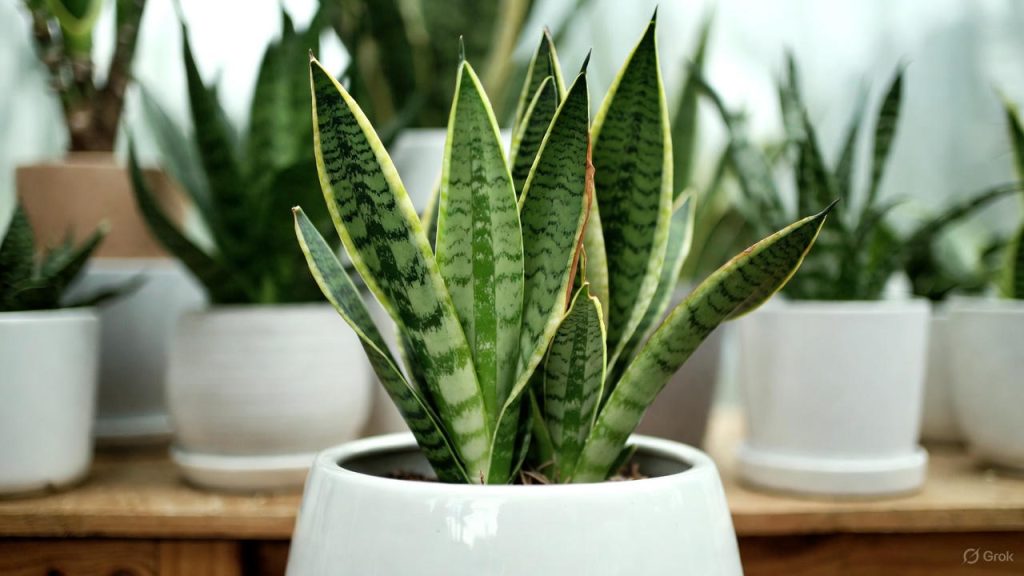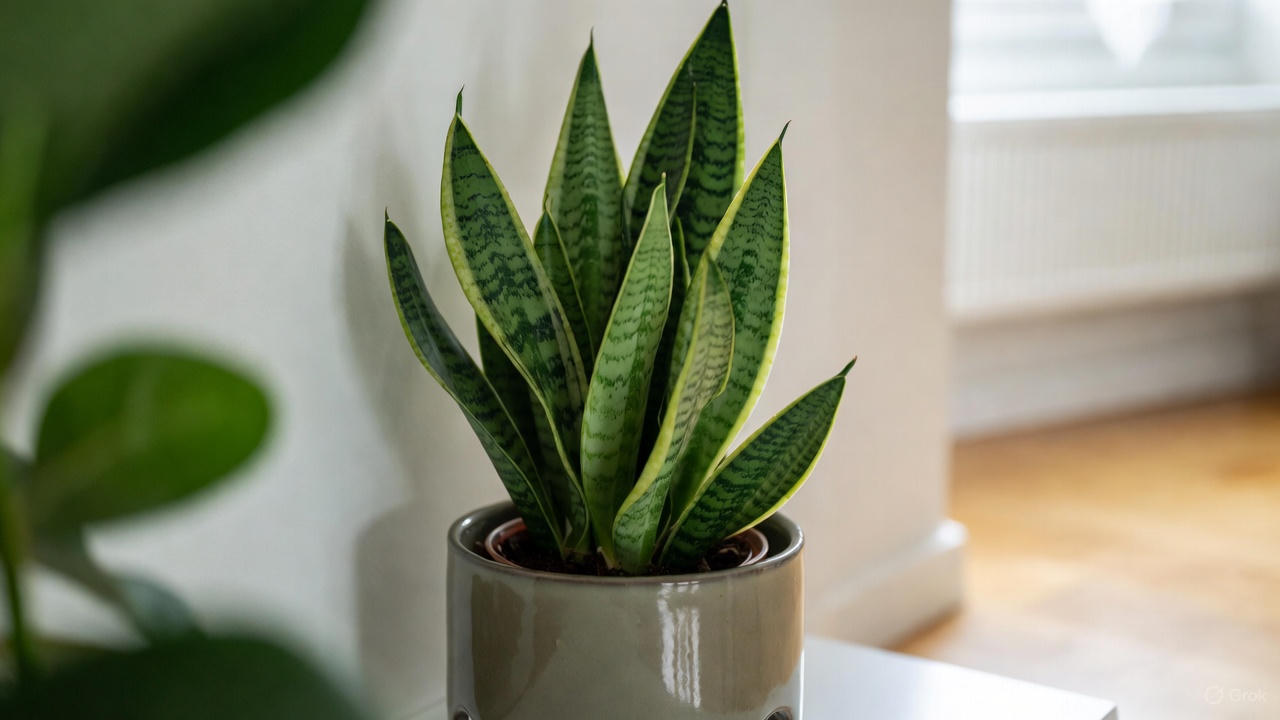How to Care for a Snake Plant?
Snake plants have become one of the most popular houseplants in recent years, and for good reason. These tough, striking plants forgive almost every mistake you throw at them. If you’ve killed every plant you’ve ever owned, the snake plant might just be your redemption story.
I’ve kept snake plants for over a decade now, and they’ve survived my neglect, my over-enthusiasm, dark corners, and bright windows. Today, I’m sharing everything I’ve learned about keeping these incredible plants happy and thriving.
What Makes Snake Plants So Special
Before we dive into care instructions, let’s talk about why these plants deserve a spot in your home. Snake plants, scientifically known as Sansevieria or Dracaena trifasciata, come from the dry regions of West Africa. They’ve evolved to survive harsh conditions with minimal water and unpredictable light.
The leaves grow upright in a striking sword-like shape. Most varieties show beautiful patterns of dark green, light green, and sometimes yellow or white. The most common type features dark green horizontal bands on lighter green leaves, which is why some people call them “mother-in-law’s tongue.”
These plants clean your indoor air by removing toxins like formaldehyde and benzene. NASA included them in their famous Clean Air Study, which tested plants for their air-purifying abilities. At night, snake plants release oxygen, making them excellent bedroom companions.
Light Requirements That Actually Work
Here’s the truth about snake plant lighting: they tolerate almost anything. I’ve seen them survive in windowless bathrooms and thrive in bright, sunny spots. But tolerance doesn’t mean preference.
Your snake plant grows best in indirect bright light. Place it near a window where sunlight filters through a sheer curtain, or position it a few feet away from a south or west-facing window. In these conditions, your plant grows steadily and produces vibrant, healthy leaves.
Low light won’t kill your snake plant. I keep one in my office with only fluorescent lighting, and it’s doing fine. The growth slows dramatically, though. New leaves appear maybe once or twice a year instead of monthly during the growing season. The colors also fade slightly in dim conditions.
Direct sunlight creates problems. I learned this the hard way when I moved a plant to a sunny windowsill. The leaves developed brown, crispy patches where the sun hit them directly. If you only have bright, direct light available, move your plant back from the window or use a sheer curtain to diffuse the rays.
Can snake plants live in complete darkness? No. They need some light to photosynthesize and stay alive. A completely dark room will eventually kill any plant. Even low-light varieties need at least a little ambient light during the day.
Watering Your Snake Plant Right
This is where most people go wrong. Snake plants store water in their thick, fleshy leaves. They’re succulents, built to survive droughts. Overwatering kills more snake plants than any other problem.
Let the soil dry out completely between waterings. I check by sticking my finger about two inches into the soil. If it feels even slightly damp, I wait. When the soil feels completely dry throughout the pot, it’s watering time.
During spring and summer, I water my snake plants roughly every two to three weeks. In fall and winter, that stretches to once a month or even longer. The exact schedule depends on your home’s temperature, humidity, and light levels.
When you water, do it thoroughly. Pour water until it runs out the drainage holes at the bottom of the pot. This flushes out accumulated salts and ensures the entire root system gets moisture. Then let the excess water drain completely. Never let your snake plant sit in a saucer of water.
Watch out for these signs of overwatering:
- Yellowing leaves, especially at the base
- Mushy, soft spots on the leaves
- A foul smell coming from the soil
- Leaves falling over or becoming limp
Underwatering is much less common, but it happens. Signs include wrinkled leaves, brown tips, and leaves that feel papery or thin. If you see these symptoms, give your plant a good drink and adjust your watering schedule.
The pot matters as much as the schedule. Always use containers with drainage holes. I can’t stress this enough. Without drainage, water pools at the bottom, creating perfect conditions for root rot.
Soil Mix That Prevents Root Rot
Snake plants hate wet feet. Standard potting soil holds too much moisture for these succulents. I learned this after losing my first snake plant to root rot.
A well-draining succulent mix works perfectly. You can buy commercial cactus and succulent soil at any garden center. These mixes contain sand, perlite, or pumice that creates air pockets and allows water to drain quickly.
Want to make your own? Mix regular potting soil with coarse sand or perlite. I use a ratio of two parts potting soil to one part perlite. Some people add a handful of orchid bark for extra drainage. The goal is creating a loose, airy mixture that water flows through easily.
The soil pH doesn’t matter much. Snake plants tolerate a wide range from slightly acidic to slightly alkaline. I’ve never tested pH for my snake plants, and they’re all thriving.
Replace the soil every two to three years. Old soil breaks down and becomes compacted, holding more water than fresh mix. This is also a good time to check the roots for any problems.
Temperature and Humidity Needs
Snake plants love the same temperatures you do. They thrive in average room temperatures between 60 and 85 degrees Fahrenheit. This makes them perfect for homes and offices.
Cold damages snake plants. Keep them away from drafty windows in winter. Temperatures below 50 degrees Fahrenheit stress the plant. Frost kills them quickly. If you put your snake plant outside during summer, bring it back in before fall temperatures drop.
Hot temperatures rarely cause problems. I’ve had snake plants sit near heating vents without complaint. Very high heat might increase watering needs, but the plants handle it fine.
Humidity levels barely matter to snake plants. They evolved in dry environments and tolerate the low humidity in most homes. You don’t need to mist them or use a humidifier. I keep snake plants in my bathroom, living room, and bedroom without adjusting humidity in any room.
Fertilizing for Healthy Growth
Snake plants grow slowly even with perfect care. They don’t need much fertilizer, and too much causes more harm than good.
I fertilize my snake plants once in spring and once in early summer. That’s it. I use a balanced, diluted liquid fertilizer mixed at half the strength recommended on the bottle. Water-soluble 10-10-10 or 20-20-20 formulas work great.
Pour the diluted fertilizer onto damp soil. Never fertilize dry soil, as this can burn the roots. I water my plant first, wait an hour, then apply the fertilizer.
Stop fertilizing in fall and winter. Snake plants go dormant during shorter days and cooler temperatures. They don’t need nutrients when they’re not actively growing. Fertilizing dormant plants leads to salt buildup in the soil.
Signs of over-fertilization include brown leaf tips, white crusty residue on the soil surface, and stunted growth. If you see these symptoms, flush the soil by running water through it several times. This leaches out excess salts.
Can you skip fertilizer entirely? Yes. Snake plants survive without any supplemental nutrients. They just grow slower. I sometimes forget to fertilize for an entire year, and my plants look fine.

Repotting Without Stress
Snake plants like being slightly rootbound. They don’t need frequent repotting. I only move my plants to larger pots every three to five years.
How do you know it’s time to repot? Look for these signs:
- Roots growing out of the drainage holes
- The plant pushing itself up out of the pot
- Water running straight through without soaking in
- Severely stunted growth despite good care
Choose a pot only one or two inches larger than the current one. Going too big causes the soil to stay wet too long between waterings. Terracotta pots work beautifully because they’re porous and wick moisture away from roots.
The best time to repot is spring or early summer when the plant is actively growing. Here’s my process:
Water your plant a day or two before repotting. This makes it easier to remove from the pot and reduces transplant shock.
Gently remove the plant from its current container. You might need to squeeze plastic pots or run a knife around the inside edge. For stubborn plants, tip the pot on its side and work the root ball out slowly.
Inspect the roots carefully. Healthy roots look white or light tan. Cut away any black, mushy, or foul-smelling roots with clean scissors or pruning shears. This indicates rot.
Place fresh soil in the bottom of the new pot. Position your plant at the same depth it was growing before. Fill around the sides with more soil mix, pressing gently to remove air pockets.
Wait a few days before watering. This gives any damaged roots time to heal and prevents rot. After that, resume your normal care routine.
Propagating Snake Plants Successfully
Want more snake plants? They’re incredibly easy to propagate. You can create dozens of new plants from a single mature one.
The division method works fastest. When you repot, separate the root ball into sections. Each section needs at least three leaves and a portion of the root system. Plant each division in its own pot with fresh soil. These plants continue growing right away since they already have established roots.
Leaf cuttings take longer but let you create many plants from just a few leaves. Cut a healthy leaf into three or four-inch sections using a clean, sharp knife. Let the cuttings dry for a day or two until the cut ends callus over.
Plant the cuttings cut-end-down in moist succulent soil. Keep track of which end is which – they won’t root if planted upside down. Place the pot in bright, indirect light and keep the soil slightly moist.
Roots develop in four to eight weeks. Tiny new shoots appear from the soil after two to three months. This method requires patience, but it’s satisfying to watch new plants emerge.
There’s one catch with leaf cuttings: variegated varieties lose their color patterns. If your snake plant has yellow edges or white stripes, leaf cuttings produce plain green plants. The variegation comes from the growing point, not the leaves. To keep the variegation, you must use the division method.
Water propagation works too. Place leaf cuttings in a glass of water, cut-end-down. Change the water every few days to prevent bacterial growth. Roots appear in three to six weeks. Once the roots reach two inches long, plant the cutting in soil.
Common Problems and Solutions
Even though snake plants are tough, they still face occasional issues. Here’s how to handle the most common problems.
Yellow Leaves: Almost always means overwatering. Check the soil moisture and adjust your watering schedule. Cut off completely yellow leaves at the base – they won’t recover.
Brown Tips: Several causes create brown tips. Low humidity, fluoride in tap water, fertilizer buildup, and inconsistent watering all contribute. I use filtered or distilled water and fertilize sparingly. Trim off brown tips with clean scissors for appearance.
Drooping Leaves: In young plants, this often happens naturally as leaves mature. In established plants, drooping usually signals overwatering or root rot. Check the roots and adjust watering.
Wrinkled Leaves: This means severe underwatering. The plant is using up stored water in its leaves. Give it a thorough watering, and the leaves should plump up within a week.
No New Growth: Snake plants grow slowly, but no growth at all might indicate low light, old depleted soil, or a dormant period. Try moving the plant to brighter light or refreshing the soil.
Pests: Snake plants rarely attract pests, but occasionally spider mites, mealybugs, or fungus gnats appear. Wipe leaves with a damp cloth for mites and mealybugs. Let the soil dry out completely to eliminate fungus gnats.
Root Rot: The most serious problem. If you catch it early, you can save the plant. Remove it from the pot, cut away all rotted roots and leaves, let it dry for several days, then repot in fresh, dry soil. Wait a week before watering.
Different Varieties to Collect
Once you master basic snake plant care, you might want to explore different varieties. The plant family offers incredible diversity in size, color, and pattern.
The standard variety, Sansevieria trifasciata, shows dark green horizontal bands on lighter green leaves. It grows tall, sometimes reaching three feet or more.
Sansevieria trifasciata ‘Laurentii’ adds yellow margins along each leaf edge. This is probably the second most common variety. The yellow edges create a striking contrast.
‘Golden Hahnii’ stays compact, growing in a rosette shape under eight inches tall. The leaves show golden yellow vertical stripes. This variety works perfectly for small spaces.
‘Moonshine’ features broad, silvery-green leaves with subtle dark edges. The pale color makes it stand out from traditional green varieties. It looks almost luminescent in bright light.
‘Cylindrica’ grows round, tubular leaves instead of flat ones. Some sellers braid the leaves together, creating sculptural forms. Without training, the cylindrical leaves grow straight up.
‘Whale Fin’ produces one or two massive, paddle-shaped leaves. A mature plant looks like a giant whale fin sticking out of the pot. It’s become trendy in recent years.
All varieties need the same basic care. Some grow faster than others, and compact varieties need less frequent watering than tall ones, but the principles remain the same.
Snake Plant Toxicity Information
Here’s something important to know: snake plants are toxic to pets and humans if ingested. The leaves contain saponins, compounds that cause nausea, vomiting, and diarrhea.
Cats and dogs who chew on the leaves typically experience drooling, vomiting, and diarrhea. Most pets recover without treatment, but severe cases might need veterinary care. The toxicity is moderate – not life-threatening in most cases, but definitely unpleasant.
Small children might try to chew on the attractive leaves. The plant causes mouth irritation and stomach upset. Keep snake plants out of reach of young kids who put things in their mouths.
I still keep snake plants with my cats. They’re not interested in the tough, bitter-tasting leaves. But every pet is different. If your animals are determined plant chewers, keep snake plants on high shelves or in rooms your pets can’t access.
Decorating With Snake Plants
These architectural plants make bold design statements. Their upright growth adds vertical interest to any space.
Tall varieties work beautifully as floor plants in corners. They fill empty vertical space without taking up much floor area. I keep a five-foot-tall snake plant in my bedroom corner, and it draws the eye upward, making the room feel larger.
Compact varieties shine on desks, shelves, and side tables. Their small size fits anywhere, bringing a touch of green to spots that can’t accommodate larger plants.
Group different varieties together for visual interest. Mix tall and short types, or combine different colors and patterns. Snake plants look stunning in modern, minimalist settings, but they also work in traditional homes.
The pot matters for the overall look. Terracotta pots give a natural, casual feel. Sleek ceramic pots in white, black, or gray suit modern spaces. Woven baskets add texture and warmth.
I love using snake plants in low-light areas where other plants struggle. They’re my go-to for making dark corners more inviting. Even in dim spots, their strong vertical form creates impact.
Why Your Snake Plant is the Perfect First Plant
If you’re new to houseplants, snake plants offer the perfect starting point. They forgive mistakes that would kill most other plants. Miss a watering? No problem. Forget to fertilize? They don’t mind. Wrong light level? They adapt.
The slow growth actually works in a beginner’s favor. You’re not constantly repotting or pruning. One pot can last for years with minimal intervention. This gives you time to learn and build confidence.
Snake plants also give clear signals when something’s wrong. The symptoms of overwatering and underwatering look distinct and different from each other. You learn to read your plant’s needs.
The air-purifying qualities mean your snake plant actively improves your home environment while you learn plant care basics. You’re getting benefits even as a beginner.
Starting with a snake plant builds the skills and confidence you need for more challenging plants. Once you’ve kept a snake plant alive for a year, you’re ready to try pickier species.
Final Thoughts on Snake Plant Care
After years of growing snake plants, I still appreciate how undemanding they are. They’re proof that you don’t need a green thumb or lots of time to bring nature into your home.
The key points to remember: let the soil dry completely between waterings, use well-draining soil in a pot with drainage holes, provide moderate light, and don’t overthink it. Snake plants thrive on benign neglect.
Start with one plant and watch how it responds in your specific home conditions. You’ll quickly learn your plant’s rhythm. Some homes require watering every two weeks, while others need it once a month. Pay attention, adjust as needed, and enjoy your nearly indestructible green companion.
Snake plants prove that beautiful, beneficial houseplants don’t have to be complicated. They’re tough, forgiving, and stunning. What more could you ask for in a plant?







